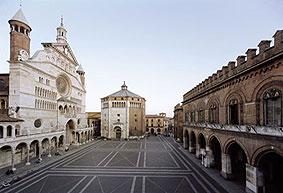


All the structures

The Lombardy province of Cremona is usually divided into five areas: the Cremonese (city centre), Casalasco to the south of the province, Cremasco to the north, the Rivolta d'Adda zone and the central area of the province headed by Castellone and Soresina.
Cremona has no mountainous areas; its lands are softened and slightly undulating due to the flow of rivers. Cremona’s topography has made agriculture particularly productive; today this is joined by equally important industrial and craft sectors.
Founded by the Romans in 218 BC, Cremona’s medieval period was particularly important for art, one example is the beautiful Torrazzo tower. The city’s symbol, the Torazzo is an impressive, 111m high bell tower dating from 1267. On the fourth floor is one of the world’s largest astrological clocks. The Torrazzo is connected to the cathedral by the sixteenth-century Bertazzola Loggia. Cremona cathedral is also a masterpiece from the 12th-13th centuries, with sixteenth-century crowning and a border of medieval reliefs. Cremona is known for its passion for string instruments. Cremona contains the work important artisans and teachers dedicate to string instruments, such as the violin. The city houses the only major violin making school in Europe. Cremona was the birthplace of Claudio Monteverdi (1567-1643).
Pizzighettone is the charming name of one of the most beautiful villages in the province of Cremona. Visit its Museum of Prisons and the Ethnographical Arts and Crafts Museum.
The brave-hearted can visit Porta Cremona during the night of a new moon, when it is said the ghost of “headless Giovanni" (the medieval tyrant-podestà of Pizzighettone, beheaded by the people) appears there.
Five kilometres from Pizzighettone is the Boscone Estate, a nature reserve of about three hundred hectares within the South Adda Regional Park.
Bicycles can be rented in the reserve and ridden along the left bank of the River Adda, following the river to reach Crotta d'Adda and Maccastorna.
Ecotourism enthusiasts shouldn’t miss the "Teaching Woods" at Castelleono, where one can experience the conservation of the flora of the plains.